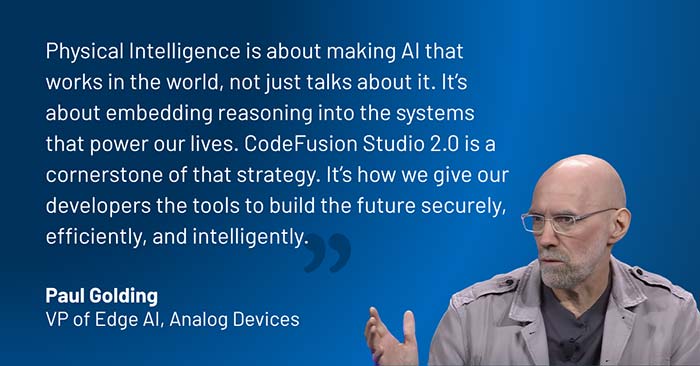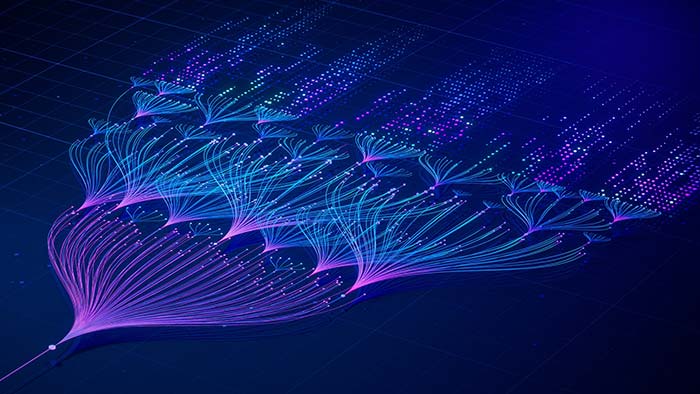For decades, industries have been waiting for AI that can reason in and about the real world. At ADI, we’re making that a reality by delivering advancements in physical intelligence – the ability for AI systems to understand and interact with the electro-physical domains where ADI has spent decades mastering signal conditioning, power, sensing, and actuation.
However, the development and deployment of AI models to embedded systems face many challenges. To realize PI, we need tools that match the complexity of the systems we’re building. That’s where CodeFusion Studio™ 2.0 comes in.
From Embedded Foundations to AI-Enabled Reasoning
Embedding AI models requires more than an Integrated Development Environment in the way technologists traditionally have understood them—it requires platforms that bridge embedded development and AI workflows. It requires the ability to develop on heterogeneous architectures that define the future of edge computing. And more importantly, it must support the kind of agentic, physics-informed intelligence that PI demands.
Let me explain why this matters.
 In the past, embedded tools were built for single-core MCUs and deterministic workflows. But PI requires systems that can reason dynamically—about thermal properties, magnetic fields, acoustic environments, and more. These aren’t static systems. They’re alive with complexity. And to build them, we need a toolchain that’s just as alive.
In the past, embedded tools were built for single-core MCUs and deterministic workflows. But PI requires systems that can reason dynamically—about thermal properties, magnetic fields, acoustic environments, and more. These aren’t static systems. They’re alive with complexity. And to build them, we need a toolchain that’s just as alive.
This is the context that informed the development of CodeFusion Studio 2.0. It supports multicore debug, system-level planning, and AI model integration—all in a unified workspace. It’s Zephyr-first and open. That means reproducibility, automation, and extensibility are baked in. For PI, this is critical. We’re building agents that reason at the edge, and those agents need to be trained, deployed, and debugged in environments that reflect the real world.
AI Workflows That Meet the Edge Where It Is
One of the most critical features of CodeFusion Studio 2.0 is its end-to-end AI pipeline. Developers can import models from TensorFlow or PyTorch and generate inference-ready code in minutes. With the Zephyr AI Profiler, they can monitor latency and memory—all without touching hardware.
This is a game-changer for PI. Our goal is to embed intelligence directly into products, whether it’s context-aware audio in hearables or adaptive control in robotics. CodeFusion Studio makes that possible. It turns AI from a bolt-on feature into a core design principle.
In addition to inference, the platform supports AutoML for Embedded, enabling dataset training and optimization within the same workflow. That means our agents can learn from the physical world, adapt to it, and act within it, all while staying within the constraints of edge hardware.
Security, Trust, and the Physical-Digital Boundary
PI also needs to be trusted. Our systems operate in critical environments, from industrial automation to healthcare. That’s why CodeFusion Studio integrates security from the ground up. With ADI’s Trusted Edge Security Architecture (TESA), developers can enforce secure boot, TrustZone partitioning, and cryptographic protocols as part of the standard workflow.
This matters because PI agents are reasoning and controlling physical systems. That control must be secure, deterministic, and auditable. CodeFusion Studio ensures that every step—from model deployment to firmware updates—is protected.
A Platform for the Future of Intelligence
At ADI, we talk about agentic AI—systems that interpret commands, reason about the world, and take action. We talk about physics-informed AI—models grounded in the laws of nature, not just statistical patterns. And we talk about neuromorphic computing—architectures that mimic the brain to run efficiently at the edge.
CodeFusion Studio™ 2.0 is a foundational system that connects all of this. It’s how we move from vision to reality. It’s how we build tools that go beyond compiling code and take on the challenge of orchestrating intelligence.
We’ve seen the potential during development. ADI teams are cutting debug cycles from days to hours. Optimized, inference-ready code is being generated in minutes. And developers—whether junior or senior—are working in environments that adapt to their needs, not the other way around.
Conclusion: Building Intelligence That Works in the World
Physical Intelligence is about making AI that works in the world—not just talks about it. It’s about embedding reasoning into the systems that power our lives. CodeFusion Studio™ 2.0 is a cornerstone of that strategy. It’s how we give our developers the tools to build the future—securely, efficiently, and intelligently.
At ADI, we go beyond imagining the future. We build it. And with CodeFusion Studio 2.0, we’re building it faster than ever.



